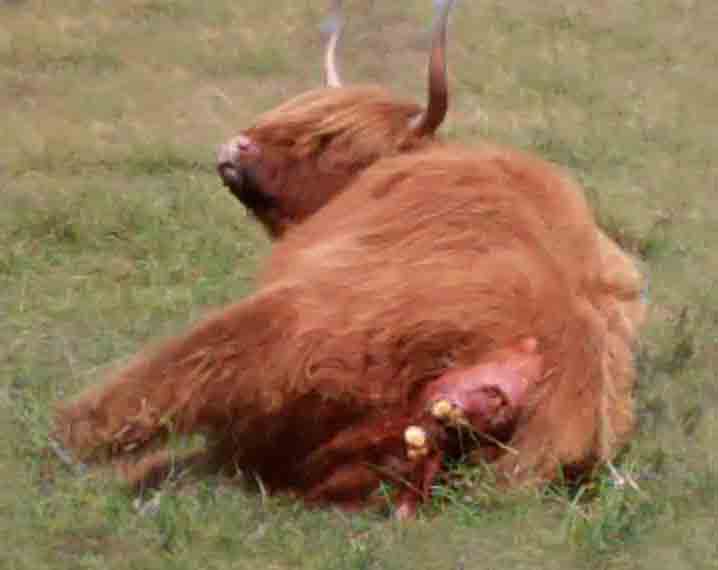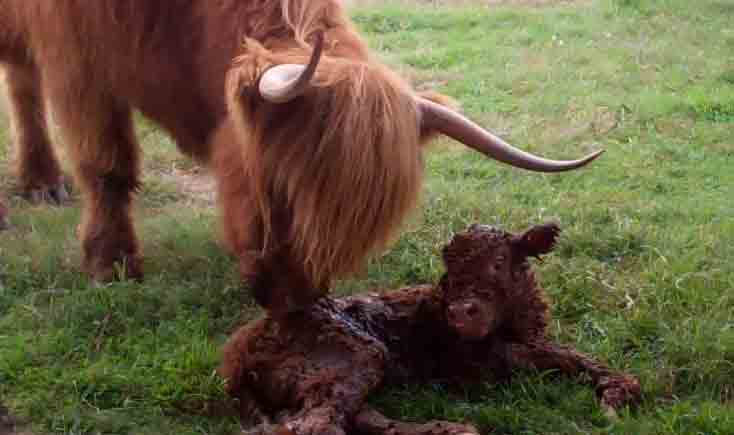Below we have listed a few points to help anyone who is experiencing a first calving.
We remember well how it felt and if you’re not sure of some of the process it can be scary. We don’t know everything but hopefully some of the points below will help to make your first experience an exciting time but most importantly give you pointers of when to be concerned and when to intervene. If you need help to calculate when your cattle are due to calve. Try our Cattle Gestation Calculator
Highland Cattle are known for their easy calving traits and being great mothers. Most of the time with our Highlands we will be out doing our routine headcount and we are missing an animal from the main herd, we’ll find our new mum and bub tucked away in a corner resting. If we are lucky enough to catch one calving we sit back and enjoy the process. Who can’t resist fluffy little calves running around the paddock!
We strive to produce a better calf each season – improving our herd continuously, so assessing the calf as it ‘hits the ground’ ( so to speak ), plays a big role in our breeding programme.
Prior to Calving
It is handy to be able to predict when your cattle are about to calve so that you can get them up close to the house about 1-2 weeks prior, where they can be monitored regularly. Level paddocks are ideal with no significant slopes or escarpments and ideally having a tree or two for shade in the secluded birthplace is ideal, but your highland will hopefully find a safe place to give birth when the time is right. If you are not sure of the calving date, there are a few tell-tale signs to look out for in the last few weeks of the pregnancy
‘bagging up / bag up’ or ‘udder movement
In a heifer the udder development can start as early as 3-4 months prior to calving. The ligaments that have held the udder up high loosen and grow allowing the impending milk to come in. Mature cows udders will enlarge 2-3 weeks prior and in some cases it can be even less. In the last few days the udder will reach the point of nearly bursting – on occasions the teats will point outwards rather than pointing towards the ground. A few days before calving they may even drip watery milk called colostrum, and if you feel the udder it will tight and can even be tender.
‘springing’
The heifer/cow’s vulva will become soft, swollen and very floppy. At about the 1-2 weeks prior and their abdomen will drop and become pendulous; they will appear more sunken on the sides. In a mature cow it is very obvious the calf has ‘dropped’. Heifers having tighter muscles it is not so clearly observed to the untrained eye. The ligaments supporting the tail head relax causing the tail head to become slightly raised.
Calving is usually 24-48 hours away at this stage. In the few days prior to calving a clear mucus plug may appear to hang from the vulva. Another tell-tale sign of imminent calving is they remove themselves from the main herd, finding a quiet place where they feel safe to calve. Saying that, I have also seen one of our cows stay within the herd when calving. It is really important to leave the heifer or cow well alone at this stage. They can try to delay the birth if they are at all worried about their surroundings. It’s time to get the binoculars out if you want to watch!
During Calving

Cow due to calve
The cow will become quite restless as contractions start. They will be up and down a lot but generally stay in the same area while checking out their surroundings. They can arch their backs up, some will keep licking at their side, most will hold their tail up in an usual manner, as seen in photo. It is obvious to see the animal is having contractions as the behaviour is not normal. The next stage is the presentation of the water-bag, the membranes surrounding the calf. It can look like a balloon filled of opaque water – this is the amniotic fluid the calf has been living in.
Possible problems at this stage – If a calf becomes distressed during this stage, it may pass meconium (fetal faeces) which usually causes the amniotic fluids to be yellowish or brownish in colour. This can be seen prior to the birth (in the sack of fluids) or when the calf has been delivered, in a brownish yellow film covering the calf – this calf may require attention

Calving
You will see obvious abdominal pushing. The heifer/cow may be grunting, some can be quite vocal and may even bellow. A normal presentation is two front feet and a nose. The soles of the little hooves will be facing the ground if they are front feet.
Possible problems at this stage – This is a really important time to note because if the hooves are facing the sky, this normally means that they are the back feet – your heifer/cow could be having a “breech” delivery and although the calf can still be born naturally – there will be a significantly higher risk of complications and the calf may need to be pulled out. There are unfortunately many other presentations, the calves neck may be back (head deviation), one leg back (retained forearm), which all will require intervention.
Don’t be alarmed if the little feet go back in – the heifer/cow will probably get up and down, and the feet may even disappear, but they will get further and further out with each contraction. The heifer/cow will also sniff and lick the amniotic fluid off the ground in-between contractions, and she will be very aware of what’s going on around her – so keep well away!
Once the head appears don’t be alarmed if the little tongue is hanging out – it certainly looks distressing, but it is not uncommon. Once the head is out, with more grunting you will be rewarded with the calves shoulders and the body can come very quickly after that! The heifer/cow may be lying down, but some also stand during the final stage, in which case the calf may drop to the ground, but this is not a problem.
The calf is usually delivered within ½ – 1 ½ hours from the first sighting of the fetal fluid. Possibly longer for a heifer, but anything over two hours suggests problems and time to intervene.
After Calving
If we are watching, we are always keen to see the mother lick the calve’s face at this stage. To make sure no membranes are over the nostrils or mouth. The heifer/cow will generally lick the little calf, and it will be trying to stand, and she may even lick so hard it will fall over. She will be talking to it constantly and still very aware of her surroundings.
Our cattle are very familiar with us and at this stage we can walk up and check the calf. PLEASE be very wary of the new Mother – she will not be afraid to protect her calf and she may see you as a threat, she is just being a good mum!
The afterbirth (placenta and membranes) will normally come away within hours, and the heifer/cow will usually eat the afterbirth so that there is no trace of it. Sounds horrible, but the afterbirth is full of valuable nutrients and helps with the ‘letting down’ of milk. It also deters predators if eaten. The cow will sometimes appear to forget about the calf to get to the afterbirth and eat it. The calf has usually had a drink by this time and resting.

Possible problems at this stage – If the membranes are retained they will be seen hanging out of the vagina and it is crucial they are removed as soon as possible to reduce the chance of infection, hindering future pregnancies. We have heard of folk leaving it for three days but we are onto it after 12-18 hours. The cotyledons (suction caps) of the placenta “hook up” to the caruncles of the uterus – care has to be taken when removing not to tear the uterus. The membranes that you can see should never be cut as sometimes the weight of them can be enough to help the process of removal. If you don’t know what you’re doing then it is time to call the vet.
The healthy calf will start struggling to its feet within minutes and should be staggering around within ½ hour or even less, trying to find its mother’s teats. Don’t be concerned if the cow is bellowing at its calf, heifers and cows can do this – it is just them talking to their calf (some are louder than others!)
The calf may appear to be struggling, and this can sometimes be hindered by a mother who has this built in instinct to clean her calf of the amniotic fluid – making the calf’s job harder to balance. It can be a very frustrating time when watching – the little calf can head towards the front two legs of the cow –while all the time struggling to balance on it four feet.
If left alone, the calf will get stronger and eventually find the ‘milk bar’. The udders may be tender and the calf’s first sucks unpleasant – we always keep an eye from afar and make sure the calf finds the udder and fills their belly within that first hour or two of being born. If we find a newborn in the paddock, we will always feel its belly to make sure it has had a feed.
This colostrum is vitally important to the health of the calf, as it contains antibodies to help build the calve’s immunity against disease. After the 24-hour mark, the gut begins to close, and it becomes extremely difficult for the calf to absorb the antibodies in the colostrum – so we always watch the calf in the first few days to make sure it feeds well.
Possible problems at this stage If you have a cow with ‘blown out’ teats or uneven teats – this can make it harder for the calf’s first drink. You may need to step in and help to strip the milk for the calf. Don’t waste it as it is full of colostrum essential for the calf’s well-being. This can be easily avoided by breeding from the best cattle with good udders and checking the bulls dam’s udder prior to joining!
If you’re fortunate enough to have a few calves born at once, the mothers will set up crèches and have one mother babysit while the others go off to graze.
PLEASE TAKE CARE – highlands can be very protective of their calves. If you have strangers or a strange dog enter the paddock they may attack. I have seen a group of heifers chasing a fox out of the paddock when the calves where only little. This showed us the whole herd are looking after the newborn calves. What great mothering traits Highlands have – we certainly don’t want to breed that out of them!

